Influence Digital Literacy on Students' Reading Interest with Consider Concentration Study Students in Social Sciences Lessons
DOI:
https://doi.org/10.59653/jemls.v2i02.819Keywords:
Digital literacy, interest in reading, concentration StudyAbstract
Education can do it too carried out through two things ie formal education. Formal education is education that can be obtained with follow activity or a structured educational program as well as planned by government agencies for example through school or university. Formulation problem is There is influence digital literacy towards interest read students, Is there is difference interest read between students who have concentration height and concentration low, Is There is influence interaction between digital literacy with concentration Study student to interest read student. Research purposes Prove exists influence interaction between digital literacy and concentration Study student to interest read student. Types of research This is experiment. According to Sugiyono (2022) method study quantitative is method research conducted with experiments used For know influence independent variable ( treatment ) towards variable dependent ( interest read ) in controlled conditions. On research experiment writer use One class the divided into two groups that is group experiments and groups control. Research result. Normality test done For know population studied normally distributed or No. And is condition for parametric tests, if significance > 0.05, then population normally distributed, if significance < 0.05 then population distribute not normal, because significance > 0.05 then decided population normal distribution.
Downloads
References
Artinata , WK, Masyhud , S., & Wardoyo, AA (2022). THE INFLUENCE OF DIGITAL PICTURE BOOK MEDIA IN LEARNING THE THEMES OF OBJECTS AROUND US ON THE LEARNING OUTCOMES OF CLASS V STUDENTS AT SDN KEDURUS 01 SURABAYA. EduStream : Journal of Elementary Education , 6 (2), 138–146. https://doi.org/10.26740/eds.v6n2.p138-146
Azzahra, A., Figiasari , D., Amelia Vega, R., & Faiz, A. (2024). THE INFLUENCE OF SOCIAL MEDIA ON WATUBELAH 1 STATE PRIMARY SCHOOL STUDENTS. Khazanah Education , 18 (1), 134. https://doi.org/10.30595/jkp.v18i1.21244
Baharudin, B. (2023). Enhancement Ability Collaboration and Digital Literacy Through Google Slides Assisted E-Mind Mapping Assignment . Journal Didactics of Elementary Education , 7 (2), 497–518. https://doi.org/10.26811/didaktika.v7i2.672
Cynthia, RE, & Sihotang , H. (2023). Moving Together in the Digital Era: The Importance Digital Literacy for Increase Ability Think Critical and Ability Student Problem Solving . 7 .
Dalimunthe , D. S. (2023). Transformation of Islamic Religious Education: Strengthening Spiritual Values , Ethics and Understanding Islam in Modern Context . Al-Murabbi: Journal of Islamic Education , 1 (1), 75–96. https://doi.org/10.62086/al-murabbi.v1i1.426
Dwicky Putra Nugraha , DM (2023). THE EFFECT OF LITERACY CLOUD ON READING INTEREST AND READING COMPREHENSION SKILLS IN CLASS IV PRIMARY STUDENTS. Elementary Journal , 6 (1), 11. https://doi.org/10.31764/elementary.v6i1.12315
Hanafiah , H., Sauri, RS, Mulyadi, D., & Arifudin , O. (2022). Countermeasures Impact of Learning Loss in Improving the Quality of Learning in Schools Upper Intermediate . JIIP - Journal Scientific Educational Science , 5 (6), 1816–1823. https://doi.org/10.54371/jiip.v5i6.642
Handayani , ST, & Saputra, BA (2023). Optimization Indonesian Language Learning with TPACK Integration and Approach Scientific through Project Based Learning on Response Text For Student Grade 9 of junior high school. TSAQOFAH , 4 (1), 189–196. https://doi.org/10.58578/tsaqofah.v4i1.2156
Isabella, I., Iriyani , A., & Puji Lestari, D. (2023). Digital Literacy as a Building Effort Character of Digital Society. Journal Government and Politics , 8 (3), 167–172. https://doi.org/10.36982/jpg.v8i3.3236
Khasanah , DW, Dewi, ANPR, & Budiwati, OS (2024). Growing Students ' Interest in Reading Through Activity Literacy in Schools . Indo -MathEdu Intellectuals Journal , 5 (1), 726–736. https://doi.org/10.54373/imeij.v5i1.620
Lubis, P., Mardianto , M., & Nasution, MIP (2023). SCHOOL LITERACY MOVEMENT: LITERACY CHALLENGES IN THE DIGITAL ERA AND HOW TO OVERCOME THEM. INFOTAMA MEDIA JOURNAL , 19 (2), 487–496. https://doi.org/10.37676/jmi.v19i2.4399
Manik, J.S. (2022). The role of teachers in Maintaining Student E-Safety in the Era of Digital Technology in Indonesia. EDUCATIVE: JOURNAL OF EDUCATIONAL SCIENCE , 4 (4), 5098–5108. https://doi.org/10.31004/edukatif.v4i4.3085
Mustofa, A., Parji , P., & Soleh, DR (2022). Implementation of the Literacy Movement School (GLS) For Growing students' interest in reading during the Covid-19 pandemic Class V SDN Rejomulyo 1. Wewarah : Journal of Multidisciplinary Education , 1 (1), 24. https://doi.org/10.25273/wjpm.v1i1.11799
Nur Khasanah , F., & Purnomo, H. (2023). STRENGTHENING CHARACTER EDUCATION IN PRIMARY STUDENTS THROUGH THE DIGITAL LITERACY MOVEMENT. IBTIDAI'Y DATOKARAMA: JOURNAL OF BASIC EDUCATION , 4 (1), 1–14. https://doi.org/10.24239/ibtidaiy.Vol4.Iss1.62
Nurhabibah , N., Habibi, M., Nursalim , N., & Risnawati , R. (2023). Utilization Let's Read application in Increase Literacy Read Student Grade 2 Elementary School . Ideas: Educational, Social , and Cultural Journal , 9 (1), 155. https://doi.org/10.32884/ideas.v9i1.1129
Panjaitan, N., Ananda, R., & Perkasa, RD (2024). Influence Digital Literacy in Social Studies Learning Ability Think Critical Student Class VIII at Muhammadiyah Middle School 22 Kisaran . 23 (1).
Pujianti , FD (2022). HIGH CLASS PRIMARY STUDENTS' READING INTEREST IN THE ONLINE LEARNING PERIOD. Journal Education Equator : Indonesian Language and Literature Learning , 5 (2), 83. https://doi.org/10.26418/ekha.v5i2.51755
Rezkiana , N.M., Manda, D., & Awaru , AOT (2023). Strengthening Character Education Student Through Learning Based Digital Literacy in Sociology Subjects at School Bosowa School Makassar Senior High School (SMA) . 7 .
Saputri , RE, Putri, AS, & Puspita, RI (2024). THE INFLUENCE OF CAREER COUNSELING SERVICES ON ELEMENTARY SCHOOL STUDENTS' READING INTEREST . 7 .
Sarnoto , AZ, Hidayat, R., Hakim, L., Alhan, K., Sari, WD, & Ika, I. (2023). Analysis Application Technology in Learning and Impact on Learning Outcomes . Journal on Education , 6 (1), 82–92. https://doi.org/10.31004/joe.v6i1.2915
Sutiyono , A. (2022). ONLINE SCHOOLS DURING THE COVID-19 PANDEMIC, HOW HAVE PRIMARY SCHOOL TEACHERS AND STUDENTS RESPONDED? 7 (1).
Umara, S., Monang , S., & Naldo, J. (2024). Revitalization Library School in Increasing Students ' Interest in Reading at School Intermediate State Vocational 1 Percut SEI Tuan . 23 (1).
Wahyuningrum , C., Anam, S., Jalil, A., Nisa, SI, Trulyana , A., Oktahariana , A., Laila, N., Hasanah, EI, Muddah , NH, Rohmah , AN, Rohmah , AM, Afifah, EN, Laily, A., & Hidayat, R. (2022). Enhancement Community Literacy through Reading Corner at Umbulrejo Village Hall . Al- Ijtimā : Journal Devotion To Society , 3 (1), 1–11. https://doi.org/10.53515/aijpkm.v3i1.47
Downloads
Published
How to Cite
Issue
Section
License
Copyright (c) 2024 Sarlin, Iskandar, Herlina

This work is licensed under a Creative Commons Attribution-ShareAlike 4.0 International License.
Authors who publish with this journal agree to the following terms:
- Authors retain copyright and grant the journal right of first publication with the work simultaneously licensed under a Creative Commons Attribution-ShareAlike that allows others to share the work with an acknowledgement of the work's authorship and initial publication in this journal.
- Authors are able to enter into separate, additional contractual arrangements for the non-exclusive distribution of the journal's published version of the work (e.g., post it to an institutional repository or publish it in a book), with an acknowledgement of its initial publication in this journal.
- Authors are permitted and encouraged to post their work online (e.g., in institutional repositories or on their website) prior to and during the submission process, as it can lead to productive exchanges, as well as earlier and greater citation of published work (See The Effect of Open Access).
























